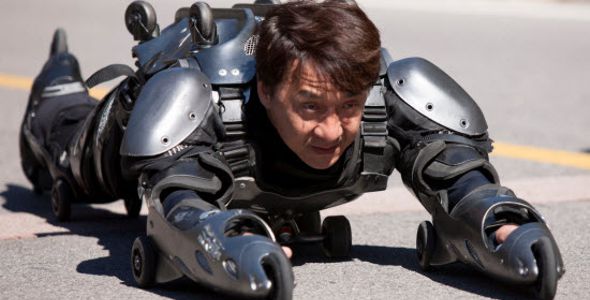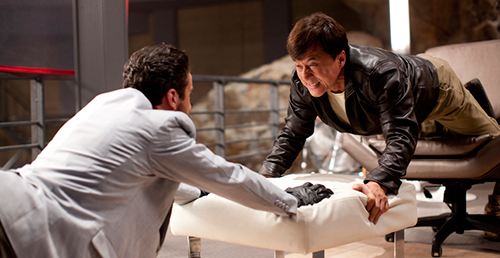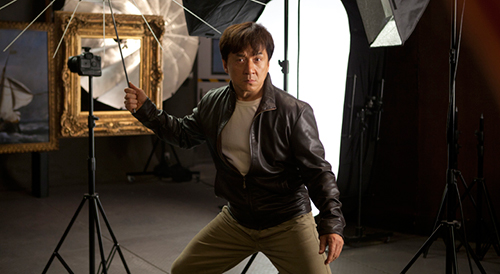 On October 18, 2013, Jackie Chan’s CHINESE ZODIAC (2012), will get a limited theatrical release in the United States. The film, also known as CZ12, is a family-friendly Kung Fu frolic, the kind of cinema that only Jackie Chan can bring to the screen. It is also the latest chapter in Jackie’s biggest fight, his epic battle with Hollywood, a rumble that has gone on now for over three decades. But before recounting that, this is about CHINESE ZODIAC, a triumphant feature where Jackie proves that, even at 58, he can still deliver Kung Fun like no one else on the planet. When it comes to action, Jackie remains fast, funny and furious.
On October 18, 2013, Jackie Chan’s CHINESE ZODIAC (2012), will get a limited theatrical release in the United States. The film, also known as CZ12, is a family-friendly Kung Fu frolic, the kind of cinema that only Jackie Chan can bring to the screen. It is also the latest chapter in Jackie’s biggest fight, his epic battle with Hollywood, a rumble that has gone on now for over three decades. But before recounting that, this is about CHINESE ZODIAC, a triumphant feature where Jackie proves that, even at 58, he can still deliver Kung Fun like no one else on the planet. When it comes to action, Jackie remains fast, funny and furious.
CHINESE ZODIAC is the kind of film that only Jackie Chan can make. This is classic Jackie – a comical farce, filled with the kind of stunts and fights that are pure Jackie. What does that mean now? For decades, Jackie has built a reputation for doing his own stunts, but in recent films he has backed away from that, delegating some of the action to his handpicked stunt team. Ironically, he has caught some flak for that. Never mind the fact that no other actor has risked life and limb as much as Jackie has, even approaching sixty, Jackie can’t catch a break. And yet, even with the wirework and special effects in CHINESE ZODIAC, there are plenty of sequences that are clearly Jackie in action, still doing more stunts than a dozen Hollywood actors half his age would. Even the most cursory comparison between Jackie’s Hollywood films and his China-made movies reveals that pure Jackie Chan action has yet to be fully imported. Hollywood still filters his work, toning it down, making it blander for the American palette.
n today’s CGI-soaked cinema, stunt work is starting to feel obsolete. Initially, the stunts in CHINESE ZODIAC don’t impress as much as they should because audiences have become desensitized to the danger. They figure it’s all wirework in front of a green screen. But this is Jackie, who loves to pull back the curtain to reveal exactly what he went through for our entertainment. CHINESE ZODIAC ends with some jaw-dropping NG (NG is short for “No Good” – this is the blooper reel that Jackie poached from Burt Reynolds in his 1981 film CANNONBALL RUN, one of Jackie’s earlier attempts to break into Hollywood). You can see Jackie slaloming down that torturous mountain road in his roller-blade suit (honestly, who but Jackie Chan could even conceive of such a thing?) And when the behind-the-scenes NG of the physics-lawbreaking parachute finale is revealed, the way Jackie got those shots is almost crazier than the scene itself.
The fight scenes in CHINESE ZODIAC have that special Jackie Chan magic. Despite the fact that Jackie has choreographed many of the most complex fights ever to be filmed, Jackie remains in the shadow of his elder brother, Hollywood’s go-to guy for Kung Fu choreography, Yuen Woo-Ping. Yuen and Jackie are actually Kung Fu brothers, both students of Master Yu Jim-Yuen and the China Drama Academy, although they weren’t studying there at the same time. In fact, dozens of martial arts movie stars can trace their roots back to this school. Yuen has choreographed THE MATRIX (1999), CROUCHING TIGER, HIDDEN DRAGON (2000), KILL BILL (2003), THE MAN WITH THE IRON FISTS (2012) – almost every major Kung Fu film distributed by Hollywood including this year’s THE GRANDMASTER and MAN OF TAI CHI. And yet, Jackie’s signature frenetic style of fight choreography doesn’t receive the same sort of adoration from Hollywood as Woo-Ping. While Woo-Ping has delivered some stylized action scenes recently, Jackie choreographs the CHINESE ZODIAC fights with his signature imaginative panache. There’s a brilliant sofa fight against a rival that is so Jackie that it hurts. There’s a great catfight between Beijing TKD champ Zhang Lanxin and stuntwoman Caitlin Dechelle. And there’s a classic fight pitting Jackie against a gang of henchmen in a hidden villain’s factory that is about to explode. What’s not to love? And even when Jackie runs away from a fight, no action film star flees with the agility and gravity-defying moves like Jackie Chan. He shows all those Parkour players that, despite what they say, he is and will always be their Daddy.

CHINESE ZODIAC is pure park-your-brain-outside fun entertainment. In fact, if you give it any thought at all, all the cartoon action comes completely undone. It’s totally family friendly. Given some of Jackie’s recent Hollywood efforts like THE KARATE KID (2010), THE SPY NEXT DOOR (2010), and FORBIDDEN KINGDOM (2008), plus some more forgettable films like THE TUXEDO (2002), THE MEDALLION (2003) and AROUND THE WORLD IN 80 DAYS (2004), family fare has been one of the many genres that Jackie has conquered long ago. After all, who can forget his cartoon series, JACKIE CHAN ADVENTURES? (If you did, it’s on Netflix.)
The real shame here is that while those other films placed Jackie into a Hollywood typecast role (typically the milquetoast that can really kick Kung Fu butt), CHINESE ZODIAC is a family-friendly film that’s all Jackie. He wrote and directed it. It’s the real authentic Jackie, at least the family-friendly one, and all those previous family-friendly farces pale by comparison. And CHINESE ZODIAC will only get a limited U.S. release, just a few dozen theaters in select markets.
Jackie’s Ongoing Hollywood Big Brawl
Long-time Jackie fans have felt the trials and tribulations of Jackie’s repeated attempts to get Hollywood’s attention. Although he is a household name in the United States today, few Americans fully grasp his impact and range. In Jackie’s autobiography, I am Jackie Chan: My Life in Action, Jackie’s attempts are broken down into three chapters, each titled “Journey to the West.” Part One describes his disappointments with his first Hollywood efforts THE BIG BRAWL (1980) and the aforementioned CANNONBALL RUN films (1981, 1984). Part Two delves into what is arguably the most abysmal of Jackie’s 100+ films, THE PROTECTOR (1985). And Part Three, the final chapter, addresses RUMBLE IN THE BRONX (1995) and the film that was just premiering when the book came out, RUSH HOUR (1998). Note that IMDB lists nearly 40 films starring Jackie Chan since the publication of I am Jackie Chan: My Life in Action. Obviously, Jackie’s autobiography is sorely in need of an update.
Ironically, Jackie premiered another film that same year titled, WHO AM I? In that film, he delivered one of his most harrowing stunts ever, Jackie’s hell-bent dash down the glass-walled side of an architecturally-unique skyscraper in Rotterdam. Despite exotic international locals and an ethnically-diverse cast, if Jackie’s American audience remembers anything about that film, it is that death-defying stunt. Unlike the three-installment RUSH HOUR franchise, WHO AM I? only had a very limited U.S. release and has since been delegated to DVD.
Most Americans see Jackie as a cartoon character, that funny Kung Fu guy, whether it be in his aforementioned JACKIE CHAN ADVENTURES, KUNG FU PANDA (2008, 2011), or even to some degree his most recent major Hollywood release, THE KARATE KID. But Jackie has played many different roles that aren’t caricature or nearly as family-friendly, and while these have been successful in Asia, they are only getting to U.S. screens via DVD and VOD. Jackie has a classic Kung Fu period-film side, as seen in LITTLE BIG SOLDIER (2010) and SHAOLIN (2011). He also has a patriotic side with nationalistic films such as THE FOUNDING OF A REPUBLIC (2009) and 1911 (2011). Like CHINESE ZODIAC, 1911 also enjoyed a limited U.S. theatrical release. And then there is his dramatic side, films where he does no Kung Fu at all. These are few and far between, the most recent being SHINJUKU INCIDENT (2009). These movies were all released within the last half decade, and some are getting some exposure through Netflix, Hulu and online streaming services. They might shatter the image many Americans have of Jackie. Most Americans are completely unaware of Jackie’s diverse and prolific film roles outside Hollywood.

Which is why CHINESE ZODIAC feels like another missed opportunity for Jackie. Here is a film that would fit quite nicely into the American Jackie Chan box. It’s even got pirates as villains. With the exception of CAPTAIN PHILLIPS, pirate villains are a sure sign of family-friendly film fare. Despite being regularly snubbed by Hollywood, Jackie Chan is a worldwide celebrity, and many of his films since the late ’90s have an international sensibility. CHINESE ZODIAC caters to that, being one-third in Chinese, one-third in English and one-third in French. Like a James Bond film, it crosses borders from France to Australia to Latvia, and of course Beijing, Hong Kong and Taiwan. The film is tailor-made for international distribution. The only aspect that’s slightly awkward is that it is part three of a trilogy. And yet, this trilogy is a perfect example of Jackie’s Hollywood woes.
The first film in the trilogy was ARMOUR OF GOD (1987), Jackie’s homage to RAIDERS OF THE LOST ARK (1981). Like Indiana Jones, Jackie plays a rollicking treasure hunter in search of ancient artifacts. He even reenacts RAIDERS opening theft of a tribal treasure scene, but instead of being chased by a giant ball, he becomes a giant ball. It was during this film when Jackie suffered his worst stunt accident. A minor slip in a jump caused him to hit his head on a rock, with left a permanent hole in his skull. This gave this film a glaring continuity error: halfway through, Jackie’s hair length changes dramatically because of the operation to fix his skull. ARMOUR OF GOD is not quite family friendly, as it opens with a gratuitous topless scene and ends with an outrageous fight between Jackie and four Amazons in stiletto heels.
The second film was released theatrically in America as OPERATION CONDOR (1991), and it remains one of Jackie’s finest family-friendly films. In many ways, CHINESE ZODIAC is derivative of this film. Just as in OPERATION CONDOR, Jackie is saddled with three beautiful costars. A scene in OPERATION CONDOR where a beautiful woman loses control of a machine gun and shoots up a room is echoed in CHINESE ZODIAC. Where OPERATION CONDOR’s finale fight was in an underground wind tunnel, the finale fight of CHINESE ZODIAC is the polar opposite, a free-fall from a plane. OPERATION CONDOR opened in 1500+ U.S. theaters and earned over $10 million, which wasn’t bad for the time. It did well enough for Hollywood to go back for ARMOUR OF GOD, re-releasing it in America as OPERATION CONDOR 2. To this day, Jackie fans don’t know whether to call this franchise OPERATION CONDOR or ARMOUR OF GOD, but that’s largely irrelevant as CHINESE ZODIAC is a stand-alone film. The knowledge that it is the third installment of the franchise is just good Jackie trivia.
Jackie’s Last Action Film?
When CHINESE ZODIAC was released for the rest of the world last year, it was promoted as Jackie’s 100th film. What’s more, due to a misunderstanding at Cannes, it was promoted as Jackie’s last action film. There were claims that Jet Li would quit back in 1995 with FEARLESS (1996), and Tony Jaa was going to quit in 2010 (as if Jaa has even earned it yet: compare his dozen films to Jackie’s 100+ films and Jet’s nearly 50 films). Of course, neither of them quit. Jackie quickly refuted the claim, just as he has had to refute the internet hoax about his death this year (strangely, it was the second internet death hoax for Jackie; there was another in 2011). Jackie’s next project is a return to yet another of his famous film franchises, one of his most successful and exciting, POLICE STORY (if the ARMOUR OF GOD/OPERATION CONDOR/CHINESE ZODIAC franchise saga seems convoluted, Jackie’s POLICE STORY franchise is even more confusing). At this writing, POLICE STORY 2013 is set to premiere in Asia on Christmas Eve 2013. Maybe, with a little luck, that will get some American distribution too. Hopefully it’ll be a little wider than CHINESE ZODIAC, but when it comes to Jackie Chan, his loyal American fans will take whatever they can get.
Written by Gene Ching for KUNGFUMAGAZINE.COM
© COPYRIGHT KUNGFUMAGAZINE.COM, ALL RIGHTS RESERVED.
All other uses contact us at gene@kungfumagazine.com





